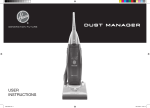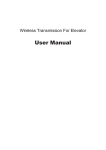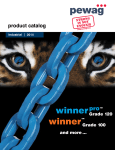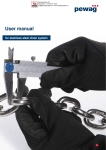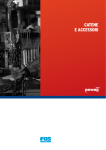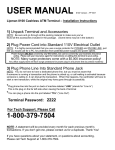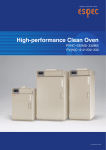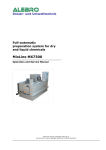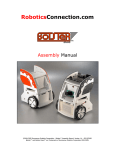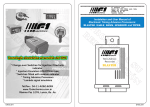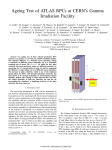Download Grade 120 User Manual - Grade 120 Chain winner pro
Transcript
A ccessories Chain and Grade 120 User Manual screws, etc.). pewag Winner Pro chains and components have only limited compatibility with chains and components of other suppliers. Compatability should be checked in advance by competent authorized people. pewag will not be responsible for any damage arising as a result of combination with products from a different supplier. User manual for assembly, use, storage and maintenance of pewag winner pro chain slings At any rate it is imperative to adapt the WLL to the weakest link in the assembly. Appropriate marking/colouring must be used to prevent the user from misinterpreting the load capacity. pewag winner pro chain slings must be labelled with specially developed identification tags for identification purposes. This tag may only be used if the WLL of the chain slings used is referred to in the table on page 4. Deviating WLL (e.g. caused due to combination with products from a different supplier) must be highlighted with a separate tag (e.g. round shape). General IB TR IS D The pewag winner pro chain system can be used in a wide range of applications. These applications must be checked for suitability by a competent authorized person, or by pewag itself in the event of doubt. One major application field of the pewag winner pro chain system is overhead lifting. The following information was prepared for this area in acc. with EN 818-6. The specifications for assembling chain slings and rating of the capacity only refer to the uniform load method with angle ranges of 0-45° and 45-60°. Restrictions of use U In addition, there is also an alternative method of rating the capacity. This method should only be used where weight and distribution of the load and the angles of the sling legs are known. In such cases please contact our technical department as the information given in this catalogue does not include details for chain sling rating using this alternative rating method! pewag winner pro lifting chains may only be assembled, tested and used by competent authorized people. D TE Effects of temperature Reduction of the load capacity caused by high temperatures, as stated on page 4, ceases once the chain and/or lifting component returns to room temperature. pewag winner pro lifting accessories may not be used outside the temperature range stated. If this has nevertheless been the case, do not use the chain slings and remove them from service. BY TU . LC ,L 16 M pewag winner pro chains and accessories may only be assembled by competent authorized people using pewag winner pro chains and accessories from the pewag winner pro chain system. When modifying or repairing pewag winner pro chain slings use only original parts supplied by pewag (e.g. bolts, safety pins, O .C Assembling chain slings IN If necessary, please contact our technical department who will be pleased to provide assistance. Working load limit The working load limits in this catalogue and those on the chain sling have been determined on the basis that the loading of the chain sling is symmetrical and there are no particularly hazardous conditions. Such hazardous conditions would be offshore applications, the lifting of people and potentially dangerous loads, such as liquid metals, corrosive or caustic substances or nuclear material. If the chain sling is to be used for such purposes, the extent of the risk is to be assessed by an expert and the safe working load be adjusted accordingly. A The shape of the chain slings must not be modified – e.g. by bending, grinding, detaching individual parts, drilling, etc. The chain slings may also not be heated to above 300°C. Do not remove any safety components, such as latches, safety pins, safety catches, etc. Do not apply any surface coatings to pewag winner pro chain slings, e.g. do not subject them to hot dip galvanizing or electrogalvanizing. Dipping or removing the coating with chemicals is also dangerous and must be agreed upon with pewag. CH Limitations on use Effects of acids, caustics and chemicals Do not subject pewag winner pro lifting accessories to acid or caustic solutions or use them in acid or caustic-laden atmospheres. Important: Certain production procedures release acids and/or fumes. Use of pewag winner pro lifting accessories in highly concentrated chemicals in combination with high temperatures is only permitted with explicit prior approval. A LS If used properly pewag winner pro lifting chains have a long service life and provide a high level of safety. Personal injury and damage to property can, however, only be prevented by proper use. It is, therefore, very important that you read and understand this user manual and act in a responsible and forward-thinking manner when using lifting equipment. Inspection and tests Before using any lifting equipment for the first time, it should be ensured that: • The chain sling corresponds exactly to the order; • The inspection certificate or certificate of conformity has been supplied; • Marking and load capacity stated on the chain sling correspond to the information given on the inspection certificate or certificate of conformity; • All particularities of the chain sling have been entered into a register of lifting equipment, if required; • Instructions for the proper use of chain sling has been supplied and read and understood by personnel. Check the chain slings before each use for visible damage or signs of wear. In case of doubt or damage do not use the chain slings and have them inspected by a competent person. After extraordinary, unusual events that could cause impairment of the chain sling, the chain sling must be checked by an expert (e.g. after exposure to uncontrolled heat). As per EN818 we recommend subjecting the chain sling every two years to a load test with 1.5 times the load capacity, followed by a visual inspection, or another type of crack test (fluxing). Maintenance and repair pewag lifting accessories and chain slings should only be repaired by qualified personnel using genuine pewag parts. Documentation Records of inspections, and in particular their findings, as well as details of repairs carried out must be kept on file during the entire service life the chain sling. Storage pewag chain sling should be stored in cleaned and dried condition and protected from corrosion, e.g. lightly lubricated. IS D Elimination criteria following visual inspection • Broken part • Missing or illegible marking of the chain sling, i.e. identification data and/or load capacity data • Deformation of suspension or sling parts or the chain itself • Elongation of the chain. The chain must be discarded if t > 1,05 tn • Wear is determined as the mean value of two measurements of diameters d1 and d2 carried out at a right angle (see picture). The chain must be discarded if dm = d1 + d2 < 0,9 dn TR Correct use of pewag winner pro chain sling IB Angle of inclination – sling points Select slinging points and chain sling type in such a way that the angles of inclination of all chain strands (legs) lie within the data given on the CE marked plate. All angles of inclination should preferably be the same. Avoid angles of inclination of less than 15°, because of the high risk of load instability. Never use chain slings with the angle of inclination exceeding 60°. D TE U 2 • For wear at the profile edges the criteria for withdrawel is d < dn BY TU hooks connecting links +5% wear at edges d = dn d -10% t +10% e +5% d2 and h -10% g +10% halves must be moveable must be given e +5% c -10% d -10% . LC links tn ,L -10% If chains are guided over edges without proper protection, their load capacity is reduced. For the corresponding load factors please refer to the table on page 9. But if chains looped at a beam or other round shaped loads the diameter should be minimum twice or 3 times the chain pitch. For smaller diameters the WLL of the chains must be reduced by 50%. M dn O .C chain IN Admissible deviation A Dimensions CH Designation A Maximum appproved dimensional change: LS • Cuts, notches, grooves, surface cracks, excessive corrosion, discoloration due to heat, signs of subsequent welding, bent or twisted links or other flaws. • Cracks: Chains with cross-cracks that are visible to the naked eye must be discarded. • Missing or non-functional safety device (safety latches if fitted) as well as signs of widening or twisting of hooks, i.e. noticeable enlargement of the opening or other forms of deformation. The enlargement of the opening must not exceed 10% of the nominal value. A jumped out safety catch shows an overload of the hook. Edge load – protection of load and chain The maximum load capacity of pewag chain slings was defined under the assumption that the individual chain legs are pulled straight under load, i.e. that they do not run over edges. In the case of edge loading, load protection (packing) should to be used to avoid damage. For correct and incorrect use see below mentioned illustrations Impact The maximum load capacity of pewag chain slings are defined under the assumption that the load on the individual chain strands (legs) is applied without any impact or shock loading. In cases of possible impact/shock, the load factors on page 10 must be taken into consideration. Impact/shock is defined as follows: • Slight impact: created, for example, when accelerating the lifting or lowering movement • Medium impact: created, for example, when the chain slips when adjusting to the shape of the load • created, for example, when the load falls into the unloaded chain 17 A ccessories Chain and Grade 120 User Manual (continues) Use of pewag chain slings for other than the intended purposes Use chain slings only for the intended purpose. In cases where not all individual strands (legs) are used simultaneously or where several chain slings are used at the same time, please refer to the load capacity table to find out the load capacity. In case of doubt or as an alternative, change the load capacity according to the following table. Vibrations pewag winner pro chains and accessories are rated according to regulations for 20,000 load cycles. At high dynamic forces there may nevertheless be a risk of damage to the chain and accessories. According to the employer’s liability insurance association Metall Nord Süd this risk may be prevented if the stress at load capacity limit is reduced by using a larger chain dimension. D IB TR IS Symmetrical loading The load capacities of pewag chain slings are defined with the assumption that the load of the individual chain strands (legs) is symmetrically distributed. Lifting of the load then leads to identical angles of inclination, and the individual strands (legs) are symmetrical to each other. U The load can still be considered symmetrical when the following conditions are met: TE D • The load is smaller than 80 % of the stated load capacity (WLL) • The chain sling leg angles to the vertial are all not less than 15° • The angles to the vertical of all chain legs are identical or deviate max. 15° from each other • In the case of three and four strand sling chains, the corresponding plan angles are within 15° of each other. BY TU Example of asymmetry Type of chain sling Number of individual strands used Use factor in relation to the loadcapacity given on the tag two-stranded (2-leg) 1 1/2 three- and fourstranded (3/4-leg) 2 2/3 three- and fourstranded (3/4-leg) 1 1/3 2x single-stranded (single leg) 2 1,4 2x two-stranded (2 leg) 3 or 4 1,5 A LS Hang any individual strands (leg) that you do not use, back into the master link to prevent hazards caused by freely swinging chains or unintended hooking. Before using several chain slings at the same time, make sure that the crane hook is big enough for all the master rings. Make sure that the master rings cannot fall out of the hook during lifting. No angles of inclination of more than 45° allowed. Use only chain slings of the same nominal thickness and grade at the same time. If all of the listed parameters are not met, load is considered to be asymmetric and an expert must be called in to assess the lifting process. In case of doubt, only one chain strand (leg) should be considered as load-bearing. For the corresponding load capacity please refer to the load capacity table. 18 . LC ,L The majority of the load is carried by 2 strand (legs) M O .C IN A CH The majority of the load is carried by 1 strand (leg) NEW Detailed user manuals are available for download at www.pewag.com.



